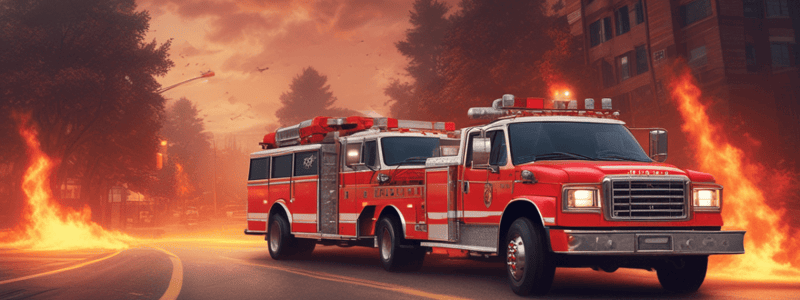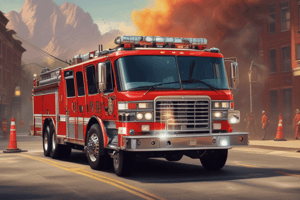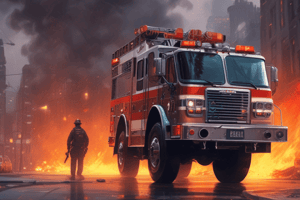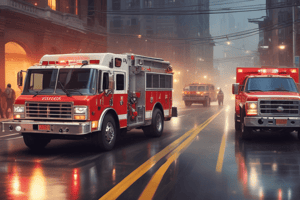Podcast
Questions and Answers
Where does the engine stop in relation to the incident within the 100' of the fire hydrant?
Where does the engine stop in relation to the incident within the 100' of the fire hydrant?
- In front of the incident within 100' of the fire hydrant (correct)
- Behind the incident within 100' of the fire hydrant
- Next to the incident within 100' of the fire hydrant
- Across the street from the incident within 100' of the fire hydrant
What is the maximum length of LDH that can be pulled from the rear of the first arriving engine?
What is the maximum length of LDH that can be pulled from the rear of the first arriving engine?
- 300' of LDH
- 200' of LDH (correct)
- 250' of LDH
- 150' of LDH
What is the role of the second engine in a reverse lay operation?
What is the role of the second engine in a reverse lay operation?
- To block traffic from the incident scene
- To supply water to the first engine (correct)
- To provide additional personnel to fight the fire
- To transport additional equipment to the scene
What is the purpose of the second engine dropping its LDH hose at the first engine in a reverse lay operation?
What is the purpose of the second engine dropping its LDH hose at the first engine in a reverse lay operation?
What is the responsibility of the engineer of the second engine if they connect the LDH directly to the fire hydrant?
What is the responsibility of the engineer of the second engine if they connect the LDH directly to the fire hydrant?
In a forward lay operation, where does the first arriving engine stop in relation to the incident scene?
In a forward lay operation, where does the first arriving engine stop in relation to the incident scene?
Who is responsible for pulling the LDH to complete the hydrant wrap in a forward lay operation?
Who is responsible for pulling the LDH to complete the hydrant wrap in a forward lay operation?
What is the purpose of pulling the LDH in a forward lay operation?
What is the purpose of pulling the LDH in a forward lay operation?
When is the LDH deployed from the engine?
When is the LDH deployed from the engine?
Who communicates the location of the looped hydrant to the second arriving engine officer?
Who communicates the location of the looped hydrant to the second arriving engine officer?
What is the primary purpose of the LDH?
What is the primary purpose of the LDH?
What does the driver/operator of the second engine do after completing the water supply assignment?
What does the driver/operator of the second engine do after completing the water supply assignment?
What is a Looped Hydrant?
What is a Looped Hydrant?
Who moves the LDH towards the curb line as it deploys from the engine?
Who moves the LDH towards the curb line as it deploys from the engine?
What is the purpose of connecting the LDH to an intake of the engine?
What is the purpose of connecting the LDH to an intake of the engine?
What does the driver/operator of the second engine do before sending water to the first engine?
What does the driver/operator of the second engine do before sending water to the first engine?
What is the responsibility of the first engine upon arriving at a fire scene?
What is the responsibility of the first engine upon arriving at a fire scene?
Under what circumstances may the first engine direct the second engine to secure a water supply?
Under what circumstances may the first engine direct the second engine to secure a water supply?
What is required for a water supply assignment change to be valid?
What is required for a water supply assignment change to be valid?
How is the method of securing the initial water supply determined?
How is the method of securing the initial water supply determined?
What type of line should the second engine lay?
What type of line should the second engine lay?
Which method is recommended for securing the initial water supply?
Which method is recommended for securing the initial water supply?
What role does the engine officer play in water supply operations?
What role does the engine officer play in water supply operations?
What is the effective date listed for the water supply Standard Operating Guidelines?
What is the effective date listed for the water supply Standard Operating Guidelines?
Flashcards are hidden until you start studying
Study Notes
Water Supply Operations
- The first engine at a fire scene is responsible for laying an initial attack line and securing a water supply, while the second engine lays a back-up or second line of equal or greater size and type as the initial attack line.
Securing Water Supply
- In certain situations, the first engine may direct the second engine to secure a water supply for the initial attack engine, which must be confirmed by radio communications.
Water Supply Methods
- Front suction on the first arriving engine:
- Engine stops within 100' of the fire hydrant.
- Driver/operator uses the 50' front suction and/or additional LDH sections to complete the water supply connection.
- LDH pulled from rear of the first arriving engine:
- Engine stops not within 125' of the fire hydrant.
- Driver/operator pulls up to 200' of LDH to complete the water supply connection.
- Reverse lay using the LDH off the second arriving engine:
- First engine stops in front of the incident and is not within 125' of the fire hydrant.
- Second engine is given the water supply assignment.
- Second engine drops its LDH hose at the first engine and reverses out to the fire hydrant.
- LDH can be connected directly to the fire hydrant or connected to the hydrant and relay pumped to the first engine.
- Forward lay using the LDH off the first arriving engine:
- First arriving engine stops at a fire hydrant before the incident scene.
- Jump Seat Firefighter or Ambulance Passenger gets out and pulls the LDH to complete the hydrant wrap.
- Engine is driven forward, deploying the LDH as it moves to the incident scene.
- LDH is connected to an intake of the engine to prepare to receive water from the second engine.
Key Definitions
- LDH: Large Diameter Hose
- Forward Lay: Hose laid from the water source to the fire
- Reverse Lay: Hose laid from the fire to the water source
- Looped Hydrant: Process of using a commercial strap attached to the end of the LDH to lead out the LDH from the hose bed.
Studying That Suits You
Use AI to generate personalized quizzes and flashcards to suit your learning preferences.




